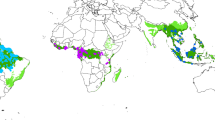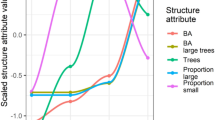Abstract
Amazonian rainforests are some of the most species-rich tree communities on earth1. Here we show that, over the past two decades, forests in a central Amazonian landscape have experienced highly nonrandom changes in dynamics and composition. Our analyses are based on a network of 18 permanent plots unaffected by any detectable disturbance. Within these plots, rates of tree mortality, recruitment and growth have increased over time. Of 115 relatively abundant tree genera, 27 changed significantly in population density or basal area—a value nearly 14 times greater than that expected by chance. An independent, eight-year study in nearby forests corroborates these shifts in composition. Contrary to recent predictions2,3,4,5, we observed no increase in pioneer trees. However, genera of faster-growing trees, including many canopy and emergent species, are increasing in dominance or density, whereas genera of slower-growing trees, including many subcanopy species, are declining. Rising atmospheric CO2 concentrations6 may explain these changes, although the effects of this and other large-scale environmental alterations remain uncertain. These compositional changes could have important impacts on the carbon storage, dynamics and biota of Amazonian forests.
This is a preview of subscription content, access via your institution
Access options
Subscribe to this journal
Receive 51 print issues and online access
$199.00 per year
only $3.90 per issue
Buy this article
- Purchase on Springer Link
- Instant access to full article PDF
Prices may be subject to local taxes which are calculated during checkout




Similar content being viewed by others
References
de Oliveira, A. A. & Mori, S. A. A central Amazonian terra firma forest. I. High tree species richness on poor soils. Biodivers. Conserv. 8, 1219–1244 (1999)
Reekie, E. G. & Bazzaz, F. A. Competition and patterns of resource use among seedlings of five tropical trees grown at ambient and elevated CO2 . Oecologia 79, 212–222 (1989)
Winter, K. & Lovelock, C. E. Growth responses of seedlings of early and late successional tropical forest trees to elevated atmospheric CO2 . Flora 194, 221–227 (1999)
Phillips, O. L. & Gentry, A. H. Increasing turnover through time in tropical forests. Science 261, 954–958 (1994)
Phillips, O. L. et al. Pattern and process in Amazon tree turnover, 1976–2001. Phil. Trans. R. Soc. B. (in the press)
Houghton, J. T. et al. (eds) Climate Change 2001: The Scientific Basis (Cambridge Univ. Press, Cambridge, UK, 2001)
Grace, J. et al. Carbon dioxide uptake by an undisturbed tropical rain forest in southwest Amazonia, 1992 to 1993. Science 270, 778–780 (1994)
Phillips, O. L. et al. Changes in the carbon balance of tropical forest: Evidence from long-term plots. Science 282, 439–442 (1998)
Baker, T. R. et al. Increasing biomass in Amazonian forest plots. Phil. Trans. R. Soc. B. (in the press)
Malhi, Y. et al. Carbon dioxide transfer over a central Amazonian rain forest. J. Geophys. Res. 103, 31593–31612 (1998)
Lewis, S. L. et al. Concerted changes in tropical forest structure and dynamics: Evidence from 50 South American long-term plots. Phil. Trans. R. Soc. B (in the press)
Phillips, O. L. et al. Increasing dominance of large lianas in Amazonian forests. Nature 418, 770–774 (2002)
Körner, C. Tropical forests in a CO2-rich world. Clim. Change 39, 297–315 (1998)
Clark, D. A., Piper, S. C., Keeling, C. D. & Clark, D. H. Tropical rain forest tree growth and atmospheric carbon dynamics linked to interannual temperature variation during 1984–2000. Proc. Natl Acad. Sci. USA 100, 5852–5857 (2003)
Condit, R., Hubbell, S. P. & Foster, R. B. Assessing the response of plant functional types to climatic change in tropical forests. J. Veg. Sci. 7, 405–416 (1996)
Tian, H. et al. Effect of interannual climate variability on carbon storage in Amazonian ecosystems. Nature 396, 664–667 (1998)
Wielicki, B. A. et al. Evidence for large decadal variability in tropical mean radiative energy budget. Science 295, 841–844 (2002)
Artaxo, P. et al. Dry and wet deposition in Amazonia: from natural biogenic aerosols to biomass burning impacts. Int. Glob. Atmos. Chem. Newsl. 27, 12–16 (2003)
Laurance, W. F. et al. Biomass collapse in Amazonian forest fragments. Science 278, 1117–1118 (1997)
Laurance, W. F. et al. Rainforest fragmentation kills big trees. Nature 404, 836 (2000)
ter Steege, H. & Hammond, D. S. Character convergence, diversity, and disturbance in tropical rain forest in Guyana. Ecology 82, 3197–3212 (2001)
Casper, B. B., Heard, S. B. & Apanius, V. Ecological correlates of single-seededness in a woody tropical flora. Oecologia 90, 212–217 (1992)
Piperno, D. R. & Becker, P. Vegetation history of a site in the central Amazon Basin derived from phytolith and charcoal records from natural soils. Quat. Res. 45, 202–209 (1996)
Dunbar, R. B. El Niño—clues from corals. Nature 407, 956–959 (2000)
Timmermann, A. et al. Increased El Niño frequency in a climate model forced by future greenhouse warming. Nature 398, 694–697 (1999)
Wright, S. J. et al. The El Niño Southern Oscillation, variable fruit production, and famine in a tropical forest. Ecology 80, 1632–1642 (1999)
Clark, D. A. & Clark, D. B. Climate-induced annual variation in canopy tree growth in a Costa Rican tropical rain forest. J. Ecol. 82, 865–872 (1994)
Malhi, Y. & Wright, J. Spatial patterns and recent trends in the climate of tropical forest regions. Phil. Trans. R. Soc. Lond. B. (in the press)
Lewis, S. L., Malhi, Y. & Phillips, O. L. Fingerprinting the impacts of global change on tropical forests. Phil. Trans. R. Soc. Lond. B. (in the press)
Thomas, S. C. Asymptotic height as a predictor of growth and allometric characteristics in Malaysian rain forest trees. Am. J. Bot. 83, 556–566 (1996)
Acknowledgements
We thank the many taxonomic specialists and field technicians who collected and identified plant material during the study, and the A. W. Mellon Foundation, the NASA-LBA Program, the Conservation, Food and Health Foundation, the US National Science Foundation, the MacArthur Foundation, the National Institute for Amazonian Research (INPA), and the Smithsonian Institution for support. Comments from O. L. Phillips, J. A. Pounds, S. L. Lewis, S. J. Wright, K. Winter, T. R. Baker, R. K. Didham, R. Harrison, T. A. Kursar and P. D. Coley improved the manuscript.
Author information
Authors and Affiliations
Corresponding author
Ethics declarations
Competing interests
The authors declare that they have no competing financial interests.
Supplementary information
Rights and permissions
About this article
Cite this article
Laurance, W., Oliveira, A., Laurance, S. et al. Pervasive alteration of tree communities in undisturbed Amazonian forests. Nature 428, 171–175 (2004). https://doi.org/10.1038/nature02383
Received:
Accepted:
Issue Date:
DOI: https://doi.org/10.1038/nature02383
This article is cited by
-
Tree regeneration characteristics in limestone forests of the Cat Ba National Park, Vietnam
BMC Ecology and Evolution (2022)
-
Analysis of the energy balance and CO2 flow under the influence of the seasonality of climatic elements in a mangrove ecosystem in Eastern Amazon
International Journal of Biometeorology (2022)
-
Estimation of carbon pools in secondary tropical deciduous forests of Odisha, India
Journal of Forestry Research (2021)
-
Amazonian rainforest tree mortality driven by climate and functional traits
Nature Climate Change (2019)
-
Stand structure, floristic composition and species diversity along altitudinal gradients of a Bornean mountain range 30 years after selective logging
Journal of Mountain Science (2019)
Comments
By submitting a comment you agree to abide by our Terms and Community Guidelines. If you find something abusive or that does not comply with our terms or guidelines please flag it as inappropriate.



